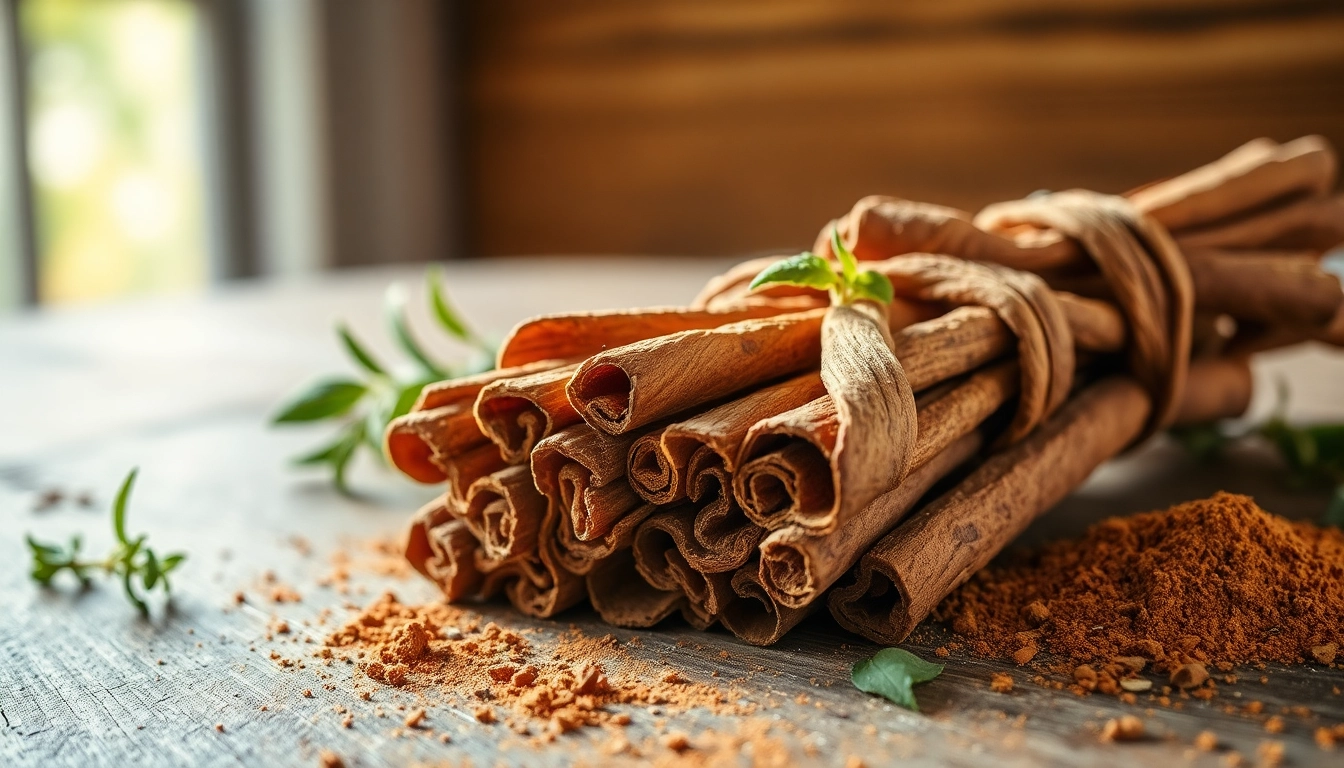Understanding Cinnamon Bark
What is Cinnamon Bark?
Cinnamon bark is the aromatic inner layer of the bark from trees belonging to the Cinnamomum family, which are predominantly found in tropical regions. Known for its distinctive flavor and fragrant aroma, cinnamon bark has been valued for both culinary and medicinal purposes for centuries. It is commonly harvested from various species, among which Ceylon (Cinnamomum verum) and Cassia (Cinnamomum cassia) are the most popular. Ceylon cinnamon is often referred to as “true” cinnamon, whereas Cassia is the variety more commonly found in grocery stores in the United States and is characterized by its thicker, harder bark and stronger flavor.
Beyond its culinary allure, cinnamon bark holds a significant place in traditional medicine. Various cultures have utilized cinnamon not only for flavoring food but also for its numerous health benefits. Its role as a potent source of antioxidants and anti-inflammatory compounds has contributed to ongoing research into its potential health benefits and applications in holistic wellness. For those interested in exploring a high-quality source for culinary and health purposes, Cinnamon Bark from trusted suppliers can provide an excellent start.
The Types of Cinnamon Bark
There are several species of cinnamon bark available, but the two most prominent are:
- Ceylon Cinnamon: Often referred to as “true cinnamon,” this type has a sweeter, more delicate flavor and is typically considered to be of higher quality. It’s known for its lower coumarin content, making it safer for regular consumption.
- Cassia Cinnamon: More prevalent in the global market, Cassia cinnamon is less expensive and has a bolder flavor. It is often available in a ground form or sold as sticks. However, it contains higher levels of coumarin, which can pose health risks if consumed in large amounts over time.
Besides these two, there are other types like Saigon cinnamon (Cinnamomum loureiroi), which originates from Vietnam and boasts a strong flavor, and Korintje cinnamon, which comes from Indonesia and is favored for its sweetness and balance of flavor. Understanding these distinctions in cinnamon species can help consumers choose the right type for their culinary needs and health considerations.
Cultural Significance of Cinnamon Bark
Cinnamon has deep roots in various cultures around the world. In ancient Egypt, cinnamon was prized for its use in embalming and religious ceremonies, demonstrating its significance beyond mere flavor. It was a symbol of wealth and a gift fit for kings. The spice made its way through trade routes, becoming a staple in Middle Eastern, Indian, and Chinese cuisines. In Traditional Chinese Medicine (TCM), cinnamon is regarded as a warming herb often used to enhance circulation, improve digestion, and combat cold symptoms.
In modern times, cinnamon continues to be celebrated in festivals and cultural practices, illustrating its enduring presence in global culinary traditions. Today, it can be found in dishes like cinnamon rolls, spiced teas, and various desserts, showcasing its versatility and appeal across diverse culinary landscapes.
Health Benefits of Cinnamon Bark
Medicinal Properties of Cinnamon Bark
Cinnamon bark is revered not just for its flavor but also for its wealth of health benefits. Numerous studies have highlighted its potential medicinal properties, which include:
- Antioxidant Effects: Cinnamon is rich in polyphenols and other antioxidant compounds that help combat oxidative stress in the body.
- Anti-inflammatory Properties: The spice has been shown to reduce inflammation, which is beneficial in managing chronic diseases.
- Antimicrobial Activity: Studies indicate that cinnamon can inhibit the growth of bacteria and fungi, potentially aiding in infection prevention.
Research continues to explore the full extent of cinnamon’s medicinal potential, making it a fascinating subject for health enthusiasts and consumers alike.
Cinnamon Bark and Digestive Health
The consumption of cinnamon bark is believed to have positive effects on digestive health. Traditionally, it has been used to alleviate gastrointestinal discomfort, with practitioners recommending it for issues such as gas, bloating, and diarrhea. Some studies suggest that cinnamon can stimulate digestive enzymes and enhance nutrient absorption. In TCM, cinnamon is often paired with other herbs to promote digestive health and improve appetite.
In addition to its digestive benefits, incorporating cinnamon into meals may help regulate blood sugar levels, which can further benefit digestive function, especially for individuals with insulin sensitivity or diabetes. Consuming cinnamon as part of a balanced diet may contribute to improved overall health and well-being.
How Cinnamon Bark Can Boost Immunity
Thanks to its rich array of antioxidants and potential antiviral properties, cinnamon bark is often touted for its ability to strengthen the immune system. Some studies indicate that the compounds found in cinnamon can bolster the body’s defenses against pathogens, offering natural support during cold and flu seasons. Additionally, cinnamon’s anti-inflammatory properties can contribute to overall wellness, helping to reduce bodily inflammation that could otherwise weaken the immune system.
When incorporated into a diet rich in fruits, vegetables, and whole grains, cinnamon can serve as an excellent complement to a holistic approach to health, encouraging a resilient immune response.
Culinary Applications of Cinnamon Bark
Using Cinnamon Bark in Cooking
Cinnamon bark can be utilized in various culinary applications, elevating flavors in both sweet and savory dishes. One common way to use cinnamon bark is by steeping it in liquids, such as water, milk, or broth, to infuse its distinctive aroma and flavor. Whole sticks can be added to stews, soups, or curries during cooking to create a depth of flavor.
When it comes to baking, while ground cinnamon is more prevalent, utilizing whole cinnamon sticks in recipes such as rice pudding or hot cider can offer a unique aromatic experience. For a more robust flavor, you can grind the cinnamon bark into a powder using a spice grinder, but this is best done in small batches as freshly ground spices are generally more flavorful.
Cinnamon Bark in Traditional Recipes
Cinnamon bark plays a prominent role in numerous traditional recipes across different cultures. In Middle Eastern cuisine, it is often combined with other spices like cumin and coriander to flavor rice dishes, stews, and kebabs. Additionally, it is a central ingredient in Moroccan tagines, bringing a warm sweetness to savory dishes.
In Western cuisine, cinnamon bark is beloved in baked goods such as cinnamon rolls, spiced cakes, and flavored coffees. Each culture has adapted cinnamon into its culinary fabric, making it a truly versatile ingredient that resonates worldwide. When cooking, consider the unique flavor profiles and health benefits that cinnamon bark can bring to your dishes.
Alternatives to Ground Cinnamon
Many recipes call for ground cinnamon, but incorporating whole cinnamon bark offers a distinct flavor experience. If you find yourself without ground cinnamon, there are several alternatives you can consider:
- Cassia Bark: As previously mentioned, Cassia cinnamon is often a more accessible option in stores and can be used in a 1:1 ratio for ground cinnamon.
- Ceylon Cinnamon: Though pricier, Ceylon cinnamon can provide a more nuanced flavor and is preferable for health-conscious consumers due to its lower coumarin content.
- Other Spices: Spices like nutmeg and allspice can be used as substitutes, though they will impart different flavors and should be used sparingly.
Experimenting with whole cinnamon bark can provide a richer flavor and aroma, particularly for those interested in exploring the subtle differences between types of cinnamon.
How to Choose Quality Cinnamon Bark
Factors to Consider When Buying
Choosing high-quality cinnamon bark is essential for maximizing its culinary and health benefits. When selecting cinnamon bark, consider the following factors:
- Type: As mentioned earlier, understanding the types of cinnamon available (Ceylon vs. Cassia) is crucial. Opt for Ceylon cinnamon for cooking and medicinal uses if you prefer a milder flavor and lower coumarin content.
- Freshness: Look for cinnamon bark that appears vibrant and aromatic. Avoid products that have a dull appearance or no scent, as these may indicate age or reduced flavor quality.
- Source: Choose sources known for quality, sustainable farming practices, and ethical harvesting methods. Checking certifications like organic can also guide your selection.
Identifying Genuine Cinnamon Bark
To ensure you are purchasing genuine cinnamon bark, consider these identification tips:
- Aroma: Fresh cinnamon bark should have a strong, sweet aroma. If it lacks fragrance, it may be old or stale.
- Appearance: Authentic Ceylon cinnamon has a soft, flexible texture and is composed of tightly rolled layers. In contrast, Cassia is harder and has a hollow shape when broken.
- Taste: Genuine Ceylon cinnamon is sweet and complex, while Cassia has a stronger, more bitter flavor.
Storing Cinnamon Bark for Optimal Freshness
To maintain the freshness and flavor of cinnamon bark, follow these storage tips:
- Airtight Containers: Always store cinnamon bark in an airtight container to minimize exposure to air, moisture, and light, which can degrade its quality over time.
- Cool, Dark Places: Keep the container in a cool, dark pantry or cupboard, away from direct sunlight and heat to preserve its aromatic properties.
- Check Expiration Dates: If purchasing commercially packaged cinnamon, always check for expiration or best-by dates to ensure quality.
The Future of Cinnamon Bark in Wellness
Emerging Research on Cinnamon Bark
As research continues to unfold, the potential health benefits of cinnamon bark may expand further. Emerging studies are investigating the effects of cinnamon on various health conditions, including:
- Diabetes Management: Preliminary findings suggest that cinnamon may help lower blood sugar levels and improve insulin sensitivity.
- Weight Management: Some studies indicate that cinnamon may play a role in weight loss by enhancing metabolism and suppressing appetite.
- Cardiovascular Health: Cinnamon’s ability to lower cholesterol and blood pressure could have significant implications for heart health.
As we learn more about its pharmacological properties, cinnamon bark may find its way into more health products, supplements, and functional foods designed to enhance wellness.
Integrating Cinnamon Bark Into a Healthy Lifestyle
Incorporating cinnamon bark into your daily routine can enhance both flavor and health. Here are some practical suggestions:
- Add to Breakfast: Stir powdered or whole cinnamon into oatmeal, yogurt, or smoothies for added flavor and nutrition.
- Infuse Beverages: Use cinnamon sticks to infuse hot drinks, such as herbal teas or mulled wine, providing warmth and flavor.
- Creative Cooking: Experiment with using cinnamon in savory cooking, including spice blends, marinades, and baking.
Integrating cinnamon into your meals and snacks can make a delicious difference while enhancing overall well-being.
Cinnamon Bark in Supplements and Extracts
A burgeoning market for cinnamon bark supplements has emerged, highlighting the interest in harnessing its health benefits. These supplements are typically available in powder, capsule, or liquid extract forms. Some considerations when exploring cinnamon supplements include:
- Quality: Look for high-quality brands with third-party testing to ensure potency and purity.
- Dosage: Consult with healthcare providers to understand appropriate dosages based on specific health goals.
- Interactions: Be aware of potential interactions with medications, especially for individuals on diabetes medications or anticoagulants.
The future of cinnamon bark in wellness appears promising, with ongoing research paving the way for innovative products that may aid in health improvement and disease prevention.




